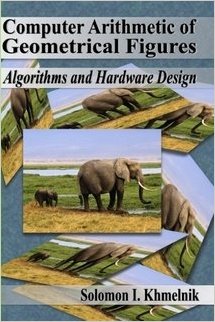
|
FreeComputerBooks.com
Links to Free Computer, Mathematics, Technical Books all over the World
|
|
- Title: Computer Arithmetic of Geometrical Figures. Algorithms and Hardware Design
- Author(s) Solomon I. Khmelnik
- Publisher: Mathematics in Computer Computers - MiC (July 13, 2011); Second Edition 2013
- Paperback: 149 pages
- eBook: PDF (150 pages, 891 KB)
- Language: English
- ISBN-10/ASIN: 1411631846
- ISBN-13: 978-1411631847
- Share This:

|
This book describes various versions of processors, designed for affine transformations of many-dimensional figures - planar and spatial. This processors is oriented to affine transformation of unstructured geometrical figures with arbitrary points distribution.
The type of data presentation used in this book is non-conventional, based on a not well-known theory of vectors and geometrical figures coding. The problems of affine transformation are used widely in science and engineering. The examples of their application are computer tomography and data compression for telecommunication systems.
The book covers the figures Coding Theory - the codes structure, algorithms of coding and decoding for planar and spatial figures, arithmetical operations with planar and spatial figures. The theory is supplemented by numerous examples. The arrangement of several versions of geometrical processor is considered - data representation, operating blocks, hardwares realization of coding, decoding and arithmetic operations algorithms. The processor's internal performance is appraised.
The book is designed for students, engineers and developers, who intend to use the computer arithmetic of geometrical figures in their own research and development in the field of specialized processors.
About the Authors- N/A
- Electronics Circuit Design
- Computer Architecture
- Algorithms and Data Structures
- Computational and Algorithmic Mathematics
- Cryptography and Coding Theory
 Similar Books:
Similar Books:
-
 Basic Computer Architecture (Smruti R. Sarangi)
Basic Computer Architecture (Smruti R. Sarangi)
This book is a comprehensive text on basic, undergraduate-level computer architecture. It includes the combinational units, ALUs, processor, basic 5-stage pipeline, and a microcode-based design.
-
 Computer Organization and Design Fundamentals (David L. Tarnoff)
Computer Organization and Design Fundamentals (David L. Tarnoff)
This book takes the reader from the basic design principles of the modern digital computer to a top-level examination of its architecture. The material is presented using practical terms and examples for a better computer systems design.
-
 Scientific Programming and Computer Architecture
Scientific Programming and Computer Architecture
The book digs into linkers, compilers, operating systems, and computer architecture to understand how the different parts of the computer interact with programs. It begins with a review of C/C++ and explanations of how libraries, linkers, and Makefiles work.
-
 Distributed Systems, 3rd Edition (Maarten van Steen, et al)
Distributed Systems, 3rd Edition (Maarten van Steen, et al)
This book covers the principles, advanced concepts, and technologies of distributed systems in detail, including: communication, replication, fault tolerance, and security. It shows how distributed systems are designed and implemented in real systems.
-
 Computer Systems: A Programmer's Perspective, 2nd Edition
Computer Systems: A Programmer's Perspective, 2nd Edition
This book introduces the important and enduring concepts that underlie computer systems by showing how these ideas affect the correctness, performance, and utility of application programs.
-
 Computer and Network Organization (Maarten van Steen, et al)
Computer and Network Organization (Maarten van Steen, et al)
Introduces the technical principles of computer architecture, operating systems and computer networks and provides a practical overview. It explains how the interaction between hardware and software takes place in relation to network operating systems.
-
 Computer Systems Companion (Daniel Taipala)
Computer Systems Companion (Daniel Taipala)
This book introduces modern digital computers and the von Neuman architectue through the cocepts of transistor gates, number representations, combinational logic circuits, sequential logic circuits, busses and control systems and definition of symbolic language to map to machine instructions and simple 2 pass assemblers.
-
 MMIXware - A RISC Computer for the Third Millennium (D. Knuth)
MMIXware - A RISC Computer for the Third Millennium (D. Knuth)
The book provides a complete documentation of the MMIX computer and its assembly language. It also presents mini-indexes, which make the programs much easier to understand.
-
 Principles of Computer System Design: An Introduction (J. Saltzer)
Principles of Computer System Design: An Introduction (J. Saltzer)
This book takes a principles-based approach to the computer system design. Through carefully analyzed case studies from each of these disciplines, it demonstrates how to apply these concepts to tackle practical system design problems.
-
 The Elements of Computing Systems: Building a Modern Computer
The Elements of Computing Systems: Building a Modern Computer
This book gives a refreshingly new way of looking at computer systems as a whole by considering all aspects of a complete system in an integrated manner, as its comes to play in the construction of a simple yet powerful computer system.
-
 Code: The Hidden Language of Computer Hardware and Software
Code: The Hidden Language of Computer Hardware and Software
Using everyday objects and familiar language systems such as Braille and Morse code, the author weaves an illuminating narrative for anyone who's ever wondered about the secret inner life of computers and other smart machines.





